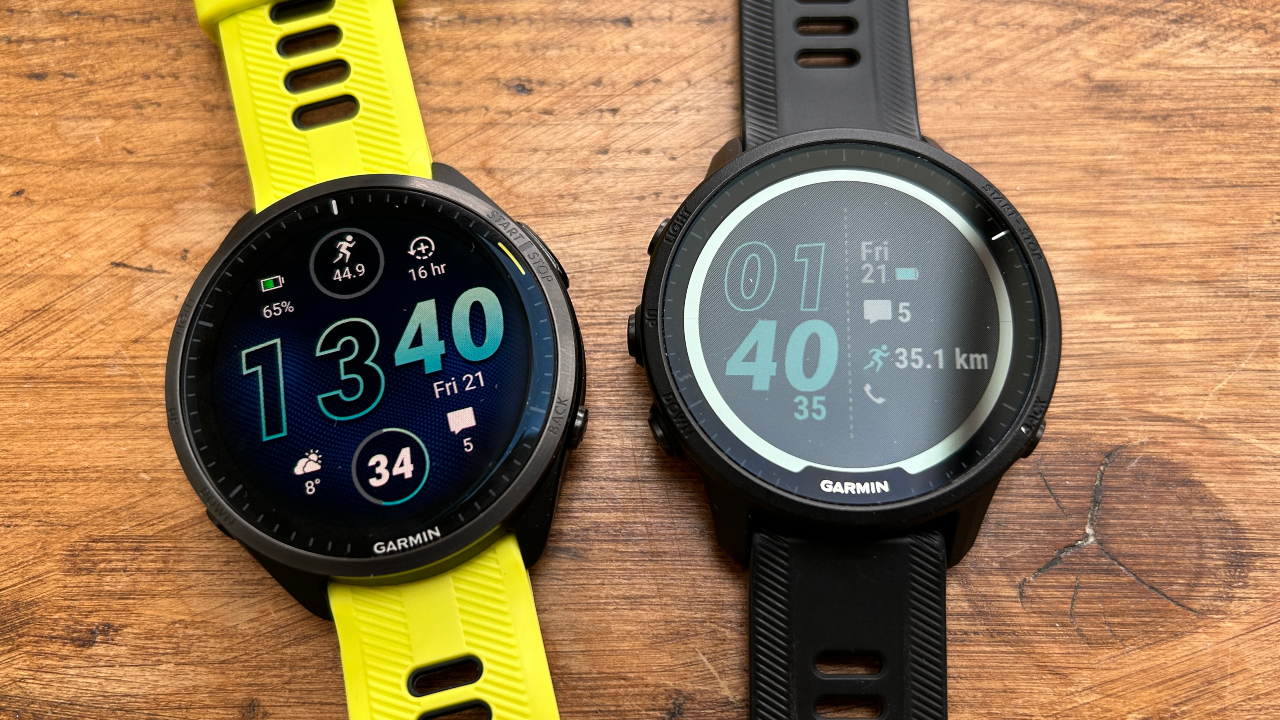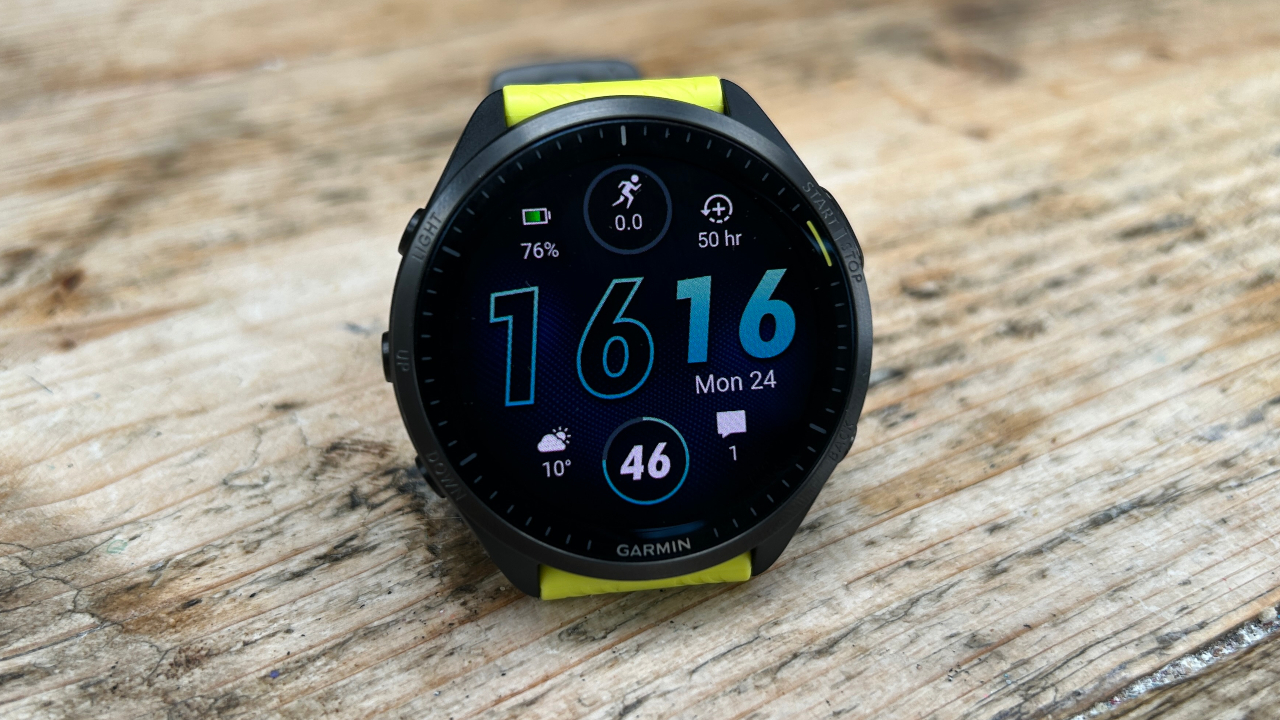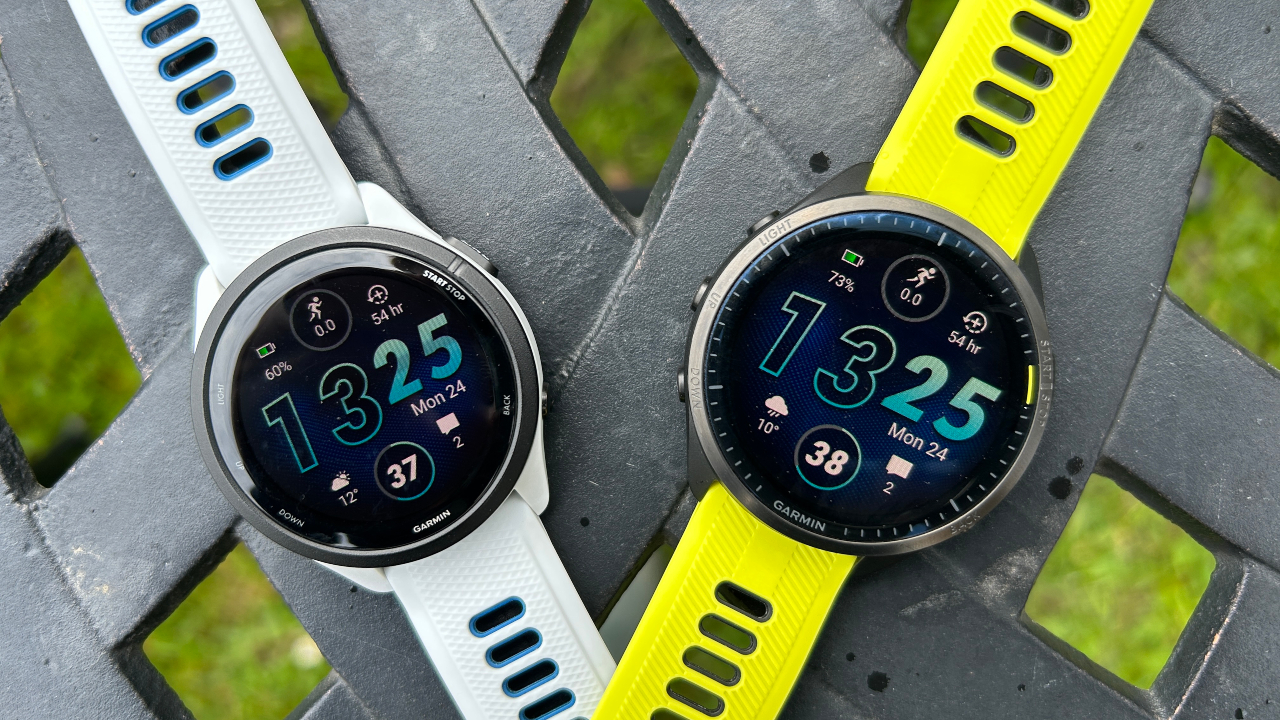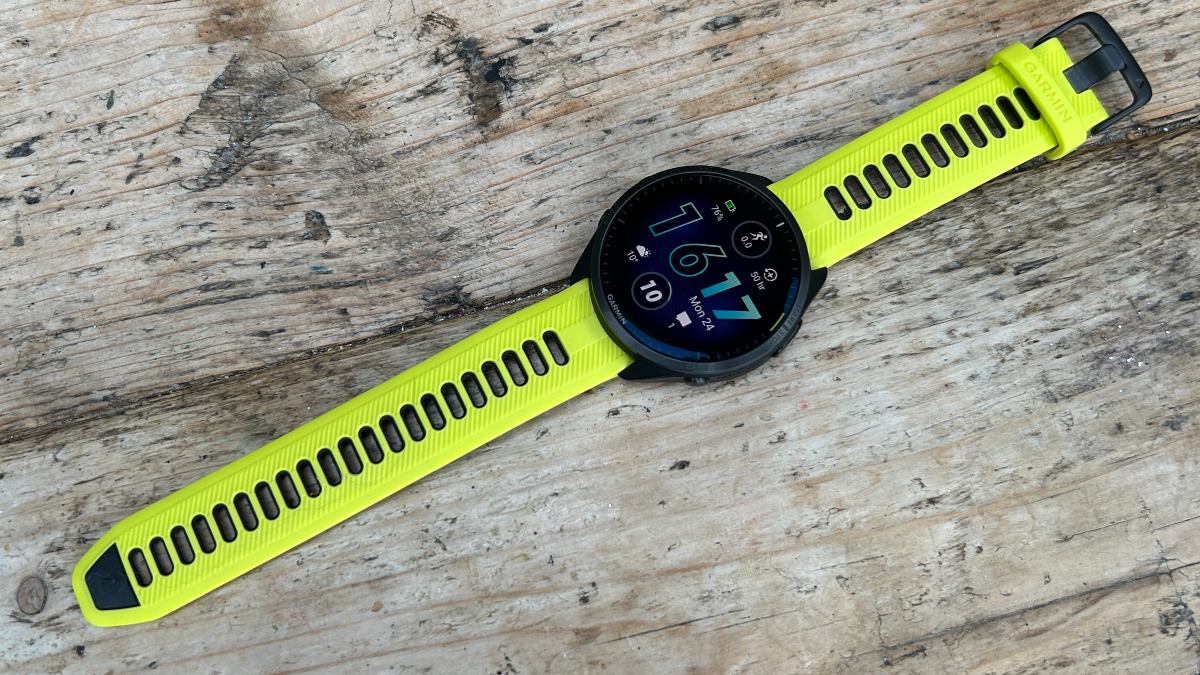Our Verdict
The Garmin Forerunner 965 adds an AMOLED screen to the already-excellent package of features offered by the Forerunner 955. It’s the best sports watch available, but there are compelling options available for less, and those who need extra-long battery life will be better served by Garmin’s other top watches.
For
- AMOLED screen
- Excellent training analysis
- Accurate sports tracking
- Music and maps
Against
- Shorter battery life than rivals
- Expensive
You can trust Coach
The Garmin Forerunner 955 is one of the best sports watches available, and given that the Garmin Forerunner 965 is more or less the same watch, with an AMOLED display and an improved design, it’s no surprise that it’s excellent.
With market-leading sports tracking, training analysis and navigation features, along with better-than-expected battery life, given the bright display, the Garmin Forerunner 965 is one of the best running watches and its only real competition comes from cheaper Garmins that have most of its features, or pricier ones that offer longer battery life.
Garmin Forerunner 965 Review: Price And Availability
The Garmin Forerunner 965 launched in March 2023 and costs $599.99 in the US and £599.99 in the UK. The Garmin Forerunner 955 costs $599.99/£549.99 for the solar version, and $499.99/£479.99 for the standard watch, though both are often in sales for less.
December 1, 2023: There are now regular sales and deals featuring the Garmin Forerunner 965. In our extensive coverage of the best Black Friday Garmin deals in 2023 the best price we tracked was $549.99.
Design And Hardware

The new AMOLED touchscreen is the star attraction on the Garmin Forerunner 965, but there are other design upgrades on the Forerunner 955. The screen is now 1.4in—an increase from 1.3in—and the resolution is 454 x 454 pixels, making it the largest and highest-resolution AMOLED display in Garmin’s range. It’s clear to read in all conditions, even in bright sunlight, and more vivid than an LCD when indoors, and under cloud cover.
The Forerunner 965 has the same 47mm case size as the Forerunner 955, and it’s even a little thinner, at 13.2mm vs 14.3mm. It weighs 52g, the same as the Forerunner 955.
A noticeable design change is the titanium bezel around the screen, which has a more elegant look than the all-plastic design of the Forerunner 955. The 965 retains the lightness and svelte look of the 9X5 line—compare it with the chunkier Fenix range, which uses larger metal bezels—and the titanium improves its design for wearing outside of sports.
Another change to the design is that the charger packaged with the watch has a USB-C connector, though the port on the watch is still the same as on most other Garmins—so you can use any older chargers you have. All the usual sensors are in place, including a barometric altimeter, compass and pulse oximeter. The 965 offers Garmin’s multi-band GPS tracking, and has a 5ATM water resistance rating. It can pair with external sensors using Bluetooth and ANT+.
Sign up for workout ideas, training advice, reviews of the latest gear and more.
Battery life is listed as up to 23 days in smartwatch mode, or seven days with the always-on screen enabled, and up to 19 hours of GPS tracking using multi-band mode, or 31 hours using GPS-only tracking.
How I Tested This Watch

I’ve been using the Garmin Forerunner 965 as my main sports watch for three weeks, during which I have tracked 15 runs, including the London Marathon, as well as a couple of cycles and several strength and yoga sessions. I tested the 965 against the Forerunner 265 for most of that period to compare the watches, and I’ve also reviewed almost all of the current Garmin range, along with older watches including the Forerunner 935, 945 and 955.
Sports Tracking And Training Analysis
The sports tracking and training analysis experience with the Forerunner 965 is the same as the Forerunner 955, along with other top Garmins like the Epix 2 and Fenix 7. It’s an excellent sports watch, offering all the stats and insights into your workouts you could want. There are also suggested workouts each day and the ability to pair with any external sensor.
Garmin introduced training readiness with the Forerunner 955 and that is the most important part of the training analysis on its watches. It provides a color-coded score that informs you how ready you are to train at any given moment, based on factors like your recent training load, stress and sleep.
There is more detail to dive into if you like, including race predictions and a breakdown of your training by intensity, plus Garmin’s new chronic training load and training load ratio, which were introduced with the 965 and are available on the 955, Epix 2, Fenix 7 and Marq 2 watches.
Your acute load—which is already on Garmin’s top watches—is your training load for the past seven days, and the chronic load looks at the past four weeks. The training load ratio compares your acute load with your chronic load to help ensure you’re not suddenly overdoing it compared with your past training.

When the two loads are equal your ratio is 1.0. You can push to 1.4 to increase your training load in a safe and effective manner, but if your ratio climbs above 1.5 you put yourself at increased risk of injury.
It’s a complicated way of presenting a simple idea, “don’t suddenly change how much training you’re doing” and I wouldn’t dive into this new stat much myself. The simple and intuitive training readiness is the most useful stat on the watch.
GPS And HR Accuracy
Garmin’s multi-band GPS tracking is the most accurate I’ve come across from any brand, and the Forerunner 965 was reliable in the pacing and distance stats it gave me. As with any GPS watch, there are times when it won’t be perfect, and it was all over the place around Canary Wharf during the London Marathon, but for the most part it was accurate.
I used the multi-band mode for almost all my runs, but you can save battery by using less accurate GPS modes, including the AutoSelect option that switches between multi-band and lower-power GPS modes, detecting what you need automatically. It’s a good idea but I haven’t noticed an increase in battery life when using this mode on Garmin watches, and prefer the security of going for the most accurate mode on my runs.
The heart rate accuracy on the Forerunner 965 is good for an optical heart rate monitor, but I noticed errors compared with the reading of a chest strap when running. Sometimes these errors are big enough to affect the training analysis of a workout, which then skews your stats for training readiness. I’d play it safe with an external heart rate monitor when using heart rate to guide my training.
Battery Life

Battery life is always going to suffer when adding an AMOLED display to a watch, though I found the Forerunner 965 surpassed my expectations on this front. With the always-on screen enabled, notifications coming in from my phone and using the multi-band GPS for all runs, it lasted seven days on a charge reliably.
This was while running 50-60 miles outdoors during that time, as well as indoor workouts. If you are a triathlete also logging a lot of cycling then you may have to knock a couple of days off what I got from the watch. There is the option to extend battery life by using raise-to-wake instead of always-on for the screen.
This is longer than what I get from the Garmin Epix 2 and Garmin Forerunner 265, which last me four to five days on a charge, and not far off the eight to 10 days I got from the Forerunner 955 Solar during my testing. If you need more battery life, the Garmin Fenix 7 or Garmin Enduro 2 watches have the same features as the 965, but use LCDs so they can last weeks on a charge.
Navigation
One area where Garmin is clear of the competition is in the navigation features on its top watches. While other brands, like Coros and Apple, offer watches with maps, the navigation features on Garmins are more advanced and easier to use.
The Forerunner 965 has all these features, with the bonus that the maps are easier to read on the AMOLED display, especially in dappled light under trees or on cloudy days. You can create routes through the Garmin Connect app and send them to the watch to follow with turn-by-turn directions, or create routes on the watch, including during activities to guide you back to your starting point.
Garmin’s ClimbPro feature is one of my favorite aspects of its navigation tools. This analyzes all the climbs and descents on your route and breaks them down one by one so you can see how much climbing or descending you have to do when you reach each hill. It makes it easier to judge effort on long runs and rides in particular.
Activity And Sleep Tracking

The Forerunner 965 tracks your steps, calories burned and steps climbed each day, and you can set the step target to automatically adjust in line with how active you are, so you always have a realistic but challenging goal. For example, mine has climbed to 16,130 after a few weeks of running 50-60 miles a week, but will come down now I’m in a recovery period after a marathon.
The sleep tracking isn’t as detailed as on watches from other brands—notably Polar and Fitbit—but you get a breakdown of your sleep stages, plus a sleep score each day. The Forerunner 965 sometimes log periods of inactivity late in the day as sleep, such as when reading or watching TV, but mostly the time logged as sleep was close to my actual time asleep.
As a keen runner, what I like about Garmin’s activity and sleep analysis is that it feeds into your training analysis, which is what I care about most on the watch. For example, if you have a restful day after a workout your recovery time needed will come down, and your sleep feeds into the training readiness stat. Since most people will be buying this as a sports watch, mostly the activity and sleep tracking can work in the background, feeding into readiness as the key stat provided by the watch.
Smart Features
The Forerunner 965 offers all of Garmin’s smart features, including NFC payments though Garmin Pay, music storage and the ability to link up with streaming services (Spotify, Deezer and Amazon Music premium accounts). It has weather forecasts and can access the Connect IQ app store—which is nothing like as impressive as the App Store or Google Play—but has useful data fields and widgets, including a parkrun barcode widget.
The addition of the AMOLED touchscreen makes the Forerunner 965 an enjoyable watch to wear at all times, and the smarts it has are useful, but it’s still not on the level of the Apple Watch Ultra on this front. The gap between the best fitness smartwatches and sports watches is closing but for now, Garmin has the edge on sports while Apple has the edge on smarts.
Is The Garmin Forerunner 965 Worth It?
I rate the Forerunner 965 as the best sports watch available. It looks great and is lighter and longer-lasting than the Garmin Epix 2. I’d rather have its AMOLED screen than the longer battery life of the Garmin Fenix 7 or Garmin Enduro 2. It’s also more affordable than those watches while having the same features.
There are cheaper watches that may suit you better, however. The Garmin Forerunner 265 has the important features of the Forerunner 965, except maps, and costs less. The 265 has an all-plastic design and shorter battery life, at around four to five days with my usage, but if you don’t need maps then I’d say it’s a better-value option.
You can also get the Garmin Forerunner 955 if you’re not tempted by the AMOLED display on the 965, saving money and getting more battery life. For now, the 955 has all the features available on the 965, though in future Garmin might not bring all its new features to the 955.
Outside of Garmin’s range there aren’t any sports watches that can compete with the 965. Coros has watches with music and maps, like the Coros Apex 2 Pro and Coros Vertix 2, but those features aren’t nearly as well developed as on Garmin watches, and the multi-band GPS is less accurate on Coros’s watches, in my experience.
Another option to investigate is the Apple Watch Ultra: it looks fantastic, is a proper smartwatch with access to a great app store, and offers accurate GPS tracking. The sports tracking and navigation on the Apple Watch Ultra aren’t as good as on the Forerunner 965, though using certain apps can close that gap, and it also lacks training analysis. The Ultra only lasts two days on a charge, but if you want a smartwatch that’s also an excellent sports watch, it’s the only option that gets close to what the Garmin Forerunner 965 offers.

Nick Harris-Fry is a journalist who has been covering health and fitness since 2015. Nick is an avid runner, covering 70-110km a week, which gives him ample opportunity to test a wide range of running shoes and running gear. He is also the chief tester for fitness trackers and running watches, treadmills and exercise bikes, and workout headphones.

